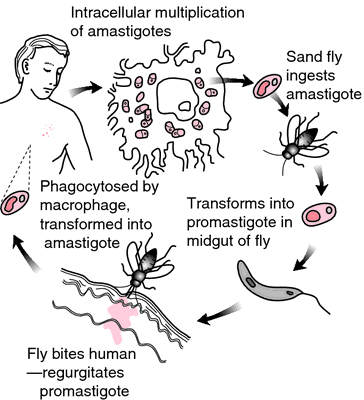Medical term:
Leishman
Leishmania
[lēsh-ma´ne-ah]a genus of protozoa comprising parasites of worldwide distribution, several species of which are pathogenic for humans. All species are morphologically indistinguishable, and therefore the organisms have usually been assigned to species and subspecies according to their geographic origin, the clinical syndrome they produce, and their ecologic characteristics. They have also been separated based on their tendency to cause visceral, cutaneous, or mucocutaneous leishmaniasis. In some classifications, Leishmania is grouped in four complexes comprising species and subspecies: L. donovani, L. tropica, L. mexicana, and L. viannia.

Life cycle of Leishmania. From Mahon and Manuselis, 2000.
Leishmania brazilien´sis Leishmania viannia.
Leishmania donova´ni donova´ni a subspecies of the L. donovani complex causing the classic form of visceral leishmaniasis in India. It is transmitted by the sandfly Phlebotomus argentipes, with humans being the only major reservoir hosts. Called also L. donovani.
Leishmania ma´jor a species of the L. tropica complex, transmitted by Phlebotomus papatasi, causing the rural form of Old World cutaneous leishmaniasis. Called also L. tropica major.
Leishmania mexica´na a complex comprising the species and subspecies causing the New World form of cutaneous leishmaniasis in humans: L. m. mexicana, L. m. amazonensis, and L. pifanoi.
Leishmania tro´pica
1. a complex comprising the species causing the Old World form of cutaneous leishmaniasis: L. tropica, L. major, and L. aethiopica.
2. a species of the L. tropica complex causing the urban form of Old World cutaneous leishmaniasis. It is found in Iran, Iraq, and India, transmitted by Phlebotomus sergenti; and in southern France, Italy and certain Mediterranean islands, transmitted by P. papatasi. Human to human transmission may also occur.
Leishmania vian´nia a taxonomic complex comprising the subspecies that cause mucocutaneous leishmaniasis in its various forms; all of the subspecies develop in the midgut, foregut, and hindgut of their sandfly vectors. Formerly called L. braziliensis.
Miller-Keane Encyclopedia and Dictionary of Medicine, Nursing, and Allied Health, Seventh Edition. © 2003 by Saunders, an imprint of Elsevier, Inc. All rights reserved.
Leishmania
(lēsh-man'ē-ă), Avoid the mispronunciation līshmā'nē-ă.A genus of digenetic, asexual, protozoan flagellates (family Trypanosomatidae) that occur as amastigotes in the macrophages of vertebrate hosts, and as promastigotes in invertebrate hosts and in cultures. Species are largely indistinguishable morphologically but may be distinguished by clinical manifestations, geographic distribution and epidemiology, developmental patterns of promastigotes in their sandfly hosts, virulence testing of clones in vivo, the effect of test sera on growth in culture, cross-immunity tests, and serotyping with promastigote excreted factors; strains also can be distinguished by various biochemical analyses and DNA sequencing. Such procedures have identified all recognized groups and confirmed the separation of New World leishmaniasis agents into two species complexes, Leishmania mexicana and Leishmania braziliensis.
[W. B. Leishman]
Farlex Partner Medical Dictionary © Farlex 2012
Leish·man·i·a
(lēsh-man'ē-ă)A genus of digenetic, asexual, protozoan flagellates that occur as amastigotes in the macrophages of vertebrate hosts, and as promastigotes in invertebrate hosts and in cultures.
[W. B. Leishman]
leish·man·i·a
, pl. leishmaniae (lēsh-man'ē-ă, -ē)A member of the genus Leishmania.
Medical Dictionary for the Health Professions and Nursing © Farlex 2012
Leishmania
A genus of single-celled organisms equipped with a whip-like motility organ (flagellated protozoon). The genus contains many species responsible for the various forms of LEISHMANIASIS, known by such names as KALA AZAR, ESPUNDIA, forest yaws, chiclero ulcer, uta, diffuse cutaneous Leishmaniasis, oriental sore, Aleppo boil, Baghdad boil, bouton d'Orient and Delhi boil.Collins Dictionary of Medicine © Robert M. Youngson 2004, 2005
Leishman,
Sir William Boog, Scottish surgeon, 1865-1926.Leishmania - a genus of digenetic, asexual, protozoan flagellates.
Leishman chrome cells - basophilic granular leukocytes (basophils) observed in the circulating blood of some persons with blackwater fever.
Leishman stain - a polychromed eosin-methylene blue stain used in the examination of blood films.
Leishman-Donovan body - the intracytoplasmic, nonflagellated leishmanial form of certain intracellular parasites. Synonym(s): amastigote; L-D body
leishmaniasis - tropical disease that is spread by sandflies.
Medical Eponyms © Farlex 2012
Latest Searches:
Weil - weightbearing - weight - Weigert - Weidel - Weichselbaum - Weichbrodt - Weibel - Wehgen - Wehamine - Wegner - Wegener - weevil - Weerd - weepiness - weep - Weeks' - Weeks - weekend - WEE -
- Service manuals - MBI Corp